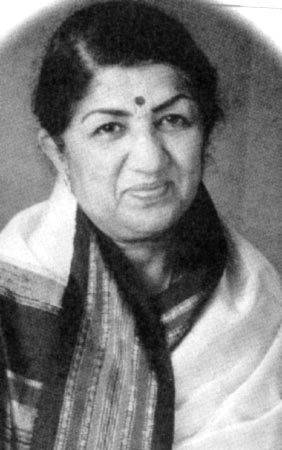
The fact that she turns 80 today, September 28, only underscores, more sharply than ever, the fact that Lata Dinanath Mangeshkar remains a living legend. How parallel, in a sense, runs Lata's career with Naushad's. So perennial in their appeal were Naushad's songs -- right through his first 30 years in films (1940-70) -- that the appeal of that era's music scored by this 'Sangeet Samrat' abides right up to 2009.
Likewise, such has been the quality of Lata's singing (as The Phenom) from 1948 to 1970 that the spell she cast through those years endures to this day, making her the diva without peer in the song lexicon of Hindustani cinema. Nothing Asha Bhosle accomplished in her later years could erase the memory of the singing Lata in her first 30 years.
How do we 'earmark' the fact that Lata is 80? I say where Lata is radically different from Asha is in her unique ability to hold a theme together on the sheer power of her vocals. It is on such thematically Lata landmark films that I initially focus to spotlight some 30 songs of her 80 evergreens.
Mughal themes offer the best opening gambit here, so let us begin with Bina Rai as Anarkali, the 1953 milestone movie that had a London paper noting: 'She sings like an angel.' The paper's reference, of course, was to Bina Rai as Anarkali. But obviously, it meant Lata. The paper's noting was going by Bina Rai's looks in the Anarkali theme song, Yeh zindagi usi ki hai, tuned by C Ramchandra in Raag Bhimpalasi.
But Ramchandra's own favourite from Anarkali -- clearly composed in a tender moment between composer and singer -- was Mohabbat aesi dhadkan hai. My favourite here is Mujh se mat poochch mere ishq mein kya rakha haibecause Majrooh Sultanpuri zeroed in upon this song to underpin his startling view that the song had 'a Maratha called C Ramchandra showing our 'Last Mughal' Naushad how to compose a ghazal!'
The beautiful thing about Anarkali is that you could take your pick from Lata's seven renditions for C Ramchandra in that period film and still be in a position to argue that it is her best effort there. So having already touched upon Yeh zindagi usi ki hai, Mohabbat aesi dhadkan hai and Mujh se mat poochch mere ishq mein kya rakha hai, I invite you to take your first choice from the Anarkali cluster of three above. Or from these four in the same 1953 Anarkali film --Duaa kar gham-e-dil, Mohabbat mein aese qadam dagmagaye, O aasmaan waale shikwa hai zindagi ka and Aa jaa ab toh aa jaa mere qismat ke kharidar ab toh aa jaa.
Do note how the above seven Anarkali ear-holders underline Lata's distinctive ability to make her vocalising quintessentially situational the secret of a singer's strength in an audio-visual medium like films.
'Majrooh said that about my ability to compose a ghazal after hearing my Khuda nigehbaan ho tumhara on Madhubala in Mughal-e-Azam, did he?' Naushad sought to know, as I took the Mujh se mat poochch SultanpuriAnarkali point to him. When I confirmed that Majrooh had been indeed comparing the music of Mughal-e-Azam to the quality of C Ramchandra's Anarkali score, Naushad shrugged shocked shoulders.
Raju Bharatan was Cinema Editor of The Illustrated Weekly Of India. He has penned Lata Mangeshkar: A Biography, priced at Rs 295, a book now out of print.
No comments:
Post a Comment